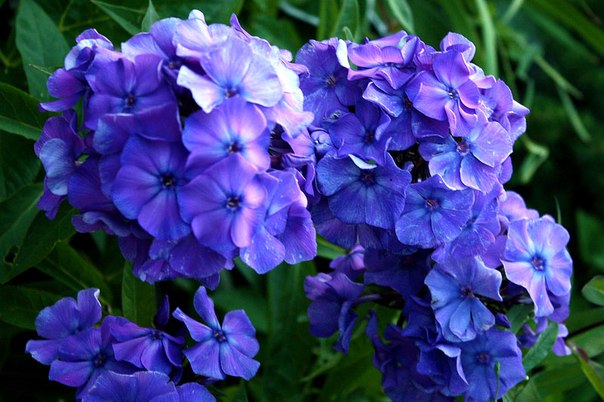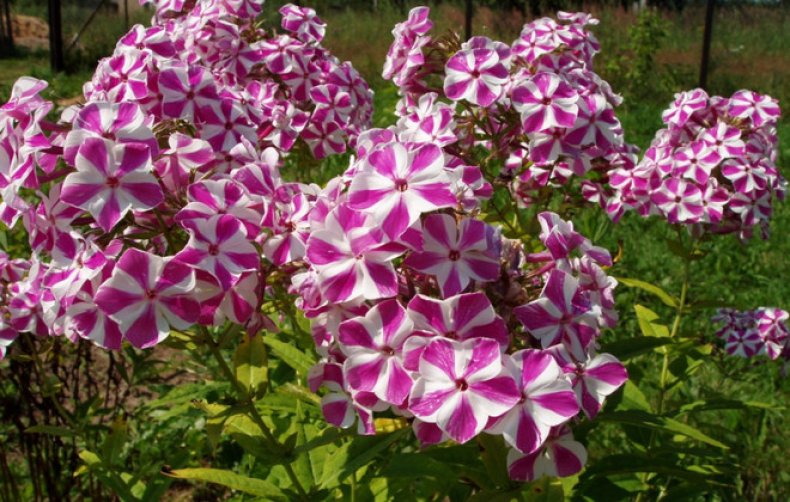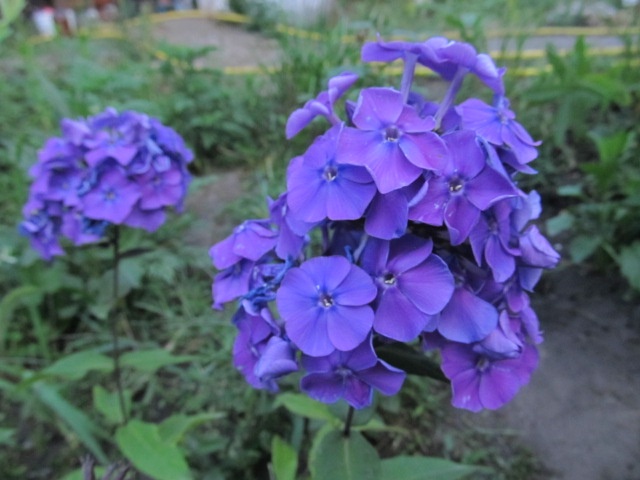Content:
The efficiency of phlox cultivation is largely determined by the varietal belonging of the plant. Priority should be given to the best varieties, one of which is Blue Paradise paniculata phlox.
Description of the culture, history of the variety
Phlox paniculata belongs to perennial herbaceous crops from the Sinyukhovye family. It naturally grows in the southeastern United States and is also cultivated worldwide as an ornamental crop. At the moment, more than 60 varieties of culture, both foreign and domestic, are known.
The origin of this variety is not known for certain. The plants were discovered in 1995 on a cut flower plot.
Brief description of the variety
Plant height varies from 70 to 120 cm. The stems are strong, darkened. The bush is characterized by a medium degree of spreading. The root system of plants is powerful, lies in the upper soil layers. It persists for many years, in contrast to the aboveground part, which dies off every year.
Stems are erect, foliage is oblong, with a pointed top. Inflorescences have a different shape and color, mainly blue and blue (with the exception of yellow, which actually does not occur). Flowers with a diameter of 2.5-4 cm, open at different times.
The advantages of the variety are the relative resistance to fungal diseases, in particular, to powdery mildew. No significant deficiencies were identified.
Agrotechnics
Finding a place for phlox
The main requirement for growing Blue Paradise is a high level of soil fertility. The plot can be either open or slightly shaded. Too shady areas are not suitable for phlox. Plants in such conditions become elongated, inflorescences become friable and turn pale, and flowering is delayed for 15-20 days.
The best option is low shrubs and sparsely planted woody plants, which will give the plantings shade in hot weather. For Blue Paradise and other blue and dark varieties, this is especially important.
It is advisable to choose a site with a slight slope. This is necessary so that during the melting of snows or prolonged rains, moisture drains from the plot without flooding the plantings. In addition, the slope will serve as a natural protection from the wind, to which phloxes are negative.
Soil preparation
For the cultivation of phlox, moist and loosened soil with a neutral pH (no higher than 7) is ideal. Fertile medium loamy soils are best suited. When planting in spring, the soil is prepared in the fall, and when planting in autumn, 2-3 weeks before it.
All weeds and debris are removed from the plot and organic fertilizer is applied to it, which is a mixture of the following ingredients:
- lime;
- low-lying peat;
- humus;
- compost;
- wood ash;
- coarse river sand.
After applying top dressing, the plot is thoroughly dug up so that the soil structure becomes homogeneous, and the lumps become smallish. It is necessary to remove all rhizomes left over from perennial weeds from the ground. If this is not done, then they will quickly drown out the plantings of phlox.
On clay, silty and other heavy soils, sand is used for loosening, and on light sandy soils, peat, manure or clay are used. It is not recommended to use wood shavings or undisturbed sawdust as fertilizer. They contain a huge number of pathogenic bacteria.
Planting phlox
Seeds are usually sown in a greenhouse in the second or third decades of March. After one and a half to two weeks, the first shoots are formed. They need to provide adequate light, humidity and warmth. After three weeks, a pick is carried out, at the end of which the plantings must be sheltered from direct sunlight using newspapers or any other suitable material.
When carrying out an autumn planting, clay areas are flavored with compost, and peat is added to sandy ones. Planting holes are dug on the plot at a distance of 50 cm from each other. Cuttings cut on adult mother plants are placed in the pits, and buried to a depth of no more than 5 cm in order to root them. 3 days after the completion of the procedure, the plants are shed profusely for 2 weeks. In rainy weather, the irrigation level is adjusted depending on the specific conditions.
Watering
Phlox Blue Paradise belongs to the category of moisture-loving plants, which usually lack soil moisture reserves. When planted too close next to other crops, Blue Paradise is usually water-stressed. In view of this, in dry weather with a prolonged absence of rain, planting maintenance should include additional irrigation directly under the bush.
It is necessary to water the plants so that the liquid does not fall on the surface of flowers and foliage. For each square meter of the area occupied by plants, it is necessary to spend up to 15-20 liters of water. It is recommended to irrigate in the evening, after sunset.
Phlox Blue Paradise reacts negatively to moisture stagnation in the root soil layer, so loosening the soil immediately after irrigation is necessary. They provide the root system with access to oxygen.
Simultaneously with loosening, it is possible to get rid of weeds that can drown out phlox. The first loosening of the soil begins in the last ten days of March and continues until the bush goes into hibernation.
Top dressing
The main and most important fertilization for Blue Paradise phlox is tied to the main stages of plant development.
So, the first feeding is carried out immediately after the snow melts. At this stage, plants grow and develop intensively, as a result of which they require nitrogen fertilizers. In this case, complex granular fertilizer is most often used. After applying top dressing, the soil is loosened to accelerate the penetration of top dressing into the soil, and then the plot is covered with mulching material to create a steam effect.
The second feeding of Blue Paradise phlox is carried out during the period of budding and flowering of plantations, which falls on the end of May - beginning of June. At this time, it is necessary to focus on the application of phosphorus and potash fertilizers, while the nitrogen content should be reduced as much as possible. In this regard, the best feeding option is mullein infusion, purchased in a specialized store or prepared on your own. It is recommended to add wood ash to it to increase efficiency.
At the end of June, the third feeding of Blue Paradise phlox is carried out.It should contain as much potassium as possible. It is also allowed to add a solution of urea at the root.
In the first decade of July, the next fertilization is carried out. It is allowed to use the same nutrients that were added the third time, however, it is recommended to add superphosphate in an amount of about 10-15 grams.
All subsequent dressings in a given season are carried out at the end of the flowering phase. In this case, it is recommended to focus on the use of complex fertilizers. The treatment of plantings of the variety with an ash solution will also bring benefits.
When using dry nutrients, apply them just before the rain. The dosage of fertilizers is usually indicated on the package, it is undesirable to exceed it.
Pruning
This procedure is carried out only after the bush has completely bloomed. Pruning usually begins at the end of September, and continues until the last October decade. At this time, all useful and nutritious elements accumulated by the plant during the growing season are transferred to the root.
Spring pruning of phlox is also practiced. It is usually carried out in regions with little snow. This pruning is due to the fact that the plant will need the shoots in the winter to keep the snow masses.
The plant is pruned, leaving about 10 cm of a bush above the ground, which will be covered with snow. Upon completion of the procedure, the near-stem sector is treated with fungicides and insecticides. The cut plant mass is most often burned.
Preparing phlox for winter
Pruning at the same time allows you to prepare the plantings for the coming winter period. Along with it, Blue Paradise phlox must be fed with fertilizers, which contain a significant amount of potash and phosphorus parts.
After feeding, the soil in the near-stem sector must be mulched with crushed horse manure. On top of it, you can lay additional covering material that will trap snow and prevent the soil from freezing.
Disease protection
The main fungal diseases affecting Blue Paradise are:
- septoria;
- powdery mildew;
- rust;
- phomosis.
The fight against them involves the use of appropriate fungicides.
Viral ailments can cause much more serious harm to plantings:
- variegation;
- curliness of foliage;
- necrotic spotting;
- rattle (leaf necrosis);
- ring spot.
It is customary to use insecticides against gnawing and sucking insects. Another category of pests includes slugs, snails, caterpillars. The most effective way to combat them is manual collection and destruction or throwing out of the plot.
Knowing the main characteristics of the Blue Paradise variety and the peculiarities of its cultivation, it is really possible to form bright flowering plantings on its basis. Blue prominent flowers will adorn any garden.















